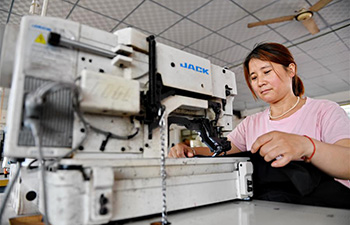SAN FRANCISCO, June 9 (Xinhua) -- New research at Stanford University indicates that big ideas are getting harder and harder to find, and innovations have become increasingly massive and costly endeavors.
According to Nicholas Bloom, a senior fellow at the Stanford Institute for Economic Policy Research (SIEPR) and co-author of a paper, so many game-changing inventions have appeared since World War II that it's become increasingly difficult to come up with the next big idea.
And as a result, tremendous continual increases in research and development (R&D) will be needed to sustain even today's low rate of economic growth.
"The thought now of somebody inventing something as revolutionary as the locomotive on their own is inconceivable," Bloom was quoted as saying in a recent news release from SIEPR.
"It's certainly true if you go back one- or two hundred years, like when Edison invented the light bulb. It's a massive piece of technology and one guy basically invented it. But while we think of Steve Jobs and the iPhone, it was a team of dozens of people who created the iPhone."
Bloom worked with SIEPR senior fellow Chad Jones, Stanford doctoral candidate Michael Webb, and Massachusetts Institute of Technology (MIT) professor John Van Reenen as co-authors to examine research productivity at an aggregate national level as well as within three swaths of industry: technology, medical research and agriculture. They analyzed research efforts at publicly traded firms.
Their paper followed a common concept that economic growth comes from people creating ideas. In other words, when there are more researchers producing more ideas, there is more economic growth.
However, the team found a not-so-rosy imbalance. While research efforts are rising substantially, research productivity, or the ideas being produced per researcher, is declining sharply.
Specifically, the number of Americans engaged in R&D has jumped by more than twentyfold since 1930 while their collective productivity has dropped by a factor of 41.
The researchers found clear evidence of how exponential investments in R&D have masked the decline in productivity.
The U.S. information technology (IT) industry's signature guidepost, Moore's Law, which marked its 52nd year in April, is a prime example.
Introduced in 1965 by Gordon Moore, the co-founder of computer chip giant Intel, the theorem postulates that the density of transistors on an integrated circuit would double roughly every two years, doubling computing power.
Moore's Law has played out, that the computing power on a chip today is remarkable compared to even a decade ago, but the study found that the research effort behind the chip innovations rose by a factor of 78 since 1971.
Put another way, the number of researchers required today to maintain the innovative pace is more than 75 times larger than the number that was required in the early 1970s.
"The constant exponential growth implied by Moore's Law has been achieved only by a staggering increase in the amount of resources devoted to pushing the frontier forward," the paper stated.
Other industries also exhibited falloffs in idea productivity. For instance, the study's co-authors used crop yields of corn, soybeans, wheat and cotton and compared them against research expenditures directed at improving yields, including cross-breeding, bioengineering, crop protection and maintenance.
The average yields across all four crops roughly doubled between 1960 and 2015. But to achieve those gains, the amount of research expended during that period rose "tremendously," anywhere from a threefold to a more-than-25-fold increase, depending on the crop and specific research measure.
On average, research productivity in agriculture fell by about 4 to 6 percent per year, the study found.
A similar pattern of greater-input-but-less-output followed in medical research. The authors analyzed R&D spending on new, federally approved U.S. drugs against life expectancy rates as a gauge of productivity, and examined decreases in mortality rates of cancer patients against medical research publications and clinical trials.
The empirical findings on breast and heart cancer suggest that at least in some areas, stated the paper, "it may get easier to find new ideas at first before getting harder."
About publicly traded companies, the study found a fraction of firms where research productivity, as measured by growth in sales, market capitalization, employment and revenue-per-worker productivity, grew decade-over-decade since 1980.
But overall, more than 85 percent of the firms showed steady, rapid declines in productivity while their spending in R&D rose.
The analysis indicated that research productivity for firms fell, on average, about 10 percent per year, and it would take 15 times more researchers today than it did 30 years ago to produce the same rate of economic growth.
"It's getting harder and harder to make new ideas, and the economy is more or less compensating for that," Bloom said. "The only way we've been able to roughly maintain growth is to throw more and more scientists at it."

















